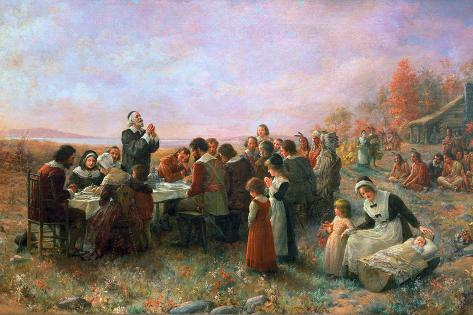The group that set out from Plymouth, in southwestern England, in September 1620 included 35 members of a radical Puritan faction known as the English Separatist Church. In 1607, after illegally breaking from the Church of England, the Separatists settled in the Netherlands, first in Amsterdam and later in the town of Leiden, where they remained for the next decade under the relatively lenient Dutch laws. Due to economic difficulties, as well as fears that they would lose their English language and heritage, they began to make plans to settle in the New World. Their intended destination was a region near the Hudson River, which at the time was thought to be part of the already established colony of Virginia.They made it to the New World but missed their mark.
Rough seas and storms prevented the Mayflower from reaching their initial destination, and after a voyage of 65 days the ship reached the shores of Cape Cod, anchoring on the site of Provincetown Harbor in mid-November. After sending an exploring party ashore, the Mayflower landed at what they would call Plymouth Harbor, on the western side of Cape Cod Bay, in mid-December. During the next several months, the settlers lived mostly on the Mayflower and ferried back and forth from shore to build their new storage and living quarters. The settlement's first fort and watchtower was built on what is now known as Burial Hill (the area contains the graves of Bradford and other original settlers).
Pilgrims Landing at Plymouth Mass
More than half of the English settlers died during that first winter, as a result of poor nutrition and housing that proved inadequate in the harsh weather.
 |
| Celebrating the first Thanksgiving |
The remaining settlers – now referred to as pilgrims – set foot on land in March 1621, when they were approached by an English-speaking Abenaki Indian. This Indian introduced the pilgrims to a man essential to their survival that winter, a Pawtuxet Indian named Squanto.We, now 317 million strong across America today, give thanks to our fore-bearers in blood and tradition. Thanks to DNA testing I now know my family has 2 percent Native American blood, so us are we more than ever.
Squanto taught the malnourished and weak pilgrims how to cultivate corn, extract sap from maple trees, catch fish in the rivers, and avoid the poisonous plants. He also helped them form an alliance with the nearby Wampanoag Indian tribe.
After the pilgrims' first successful corn harvest later that year, Governor William Bradford organized a three-day celebratory feast, and invited the neighboring Wampanoag Indian tribe. Records show that 53 colonists and 90 Wampanoag attended the first Thanksgiving.
On this Thanksgiving Day 2013 we would like to give special thanks to friends and family who graced us with their company this past year as we settled into our new Montana outpost. Thank you brother-in-law Jack, cousin Jim and his lovely wife Mary Joan, thank you the Laumanns (George, Mindy, Nikota and Retta), Teresa's college friend Ron and childhood friend Laura, and to my sister Joanne. A special thanks as well to Jack and Tina, and grandparents Doc and Mam for hosting the big kids in the Lone Star state this summer. To all, there is always room at the inn tucked here between the Bridger and Gallitan ranges. Happy Thanksgiving!

While you have much to be proud of including your sister's appearance en brief before the United States Supreme Court on behalf of Native American's fishing rights, your interpretation of the DNA is misguided. This is NOT a matter of a hook up with some Indian in recent time, but instead is a matter of your ultimate heritage.
ReplyDeleteThe above comment is by my brother Scott Foster.
ReplyDeleteHere is another comment from your brother. When I spoke with Susan Breuer today, I mentioned that I was an Evans Scholar. She replied that her all time favorite person at Glen View was an Evans Scholar named Dick Daiberl. She had not spoken to him in over 40 years. I called up Dick Daiberl, and he gave her a call. Dick Daiberl of course remembers you vividly as both a caddy and one of his first students at Park View, where he went on to teach for 33 years. He sends his highest regards to you and his love.
ReplyDeleteThe above comment is by my brother Scott Foster.
ReplyDelete